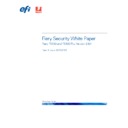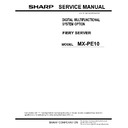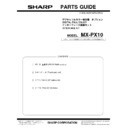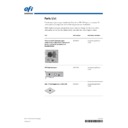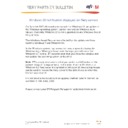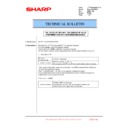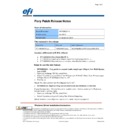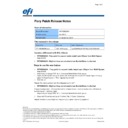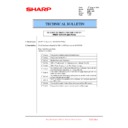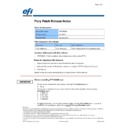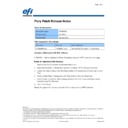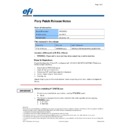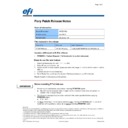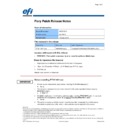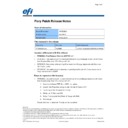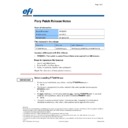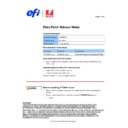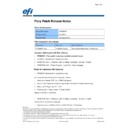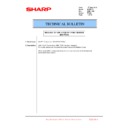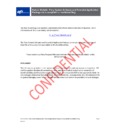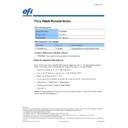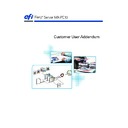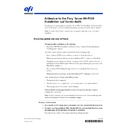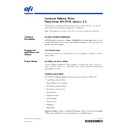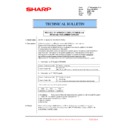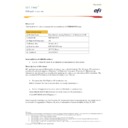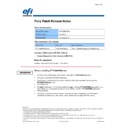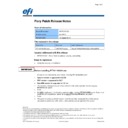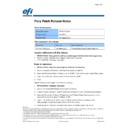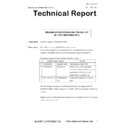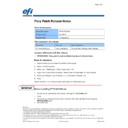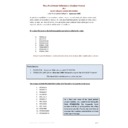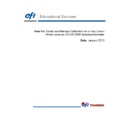Sharp MX-PE10 FIERY (serv.man47) Regulatory Data ▷ View online
9
6 Data Security
6.1 Encryption of Critical Information
Encryption of critical information in the Fiery server ensures
that all passwords and related configuration information are
secure when stored in the Fiery server. NIST 2010 compliant
cryptographic algorithms are used.
that all passwords and related configuration information are
secure when stored in the Fiery server. NIST 2010 compliant
cryptographic algorithms are used.
6.2 Standard Printing
Jobs submitted to the Fiery server may be sent to one of
the following print queues published by the Fiery server:
the following print queues published by the Fiery server:
• Hold Queue
• Print Queue
• Sequential Print Queue
• Direct Queue (Direct Connection)
• Print Queue
• Sequential Print Queue
• Direct Queue (Direct Connection)
• Virtual Printers (custom queues defined by the
Fiery Administrator).
The Fiery Administrator can disable the Print Queue and
Direct queue to limit automatic printing. With passwords
enabled on the Fiery server, this feature limits printing to
Fiery Operators and Administrators.
Direct queue to limit automatic printing. With passwords
enabled on the Fiery server, this feature limits printing to
Fiery Operators and Administrators.
6.2.1 Hold, Print and Sequential Print Queues
When a job is printed to the Print Queue or the Hold Queue,
the job is spooled to the hard drive on the Fiery server. Jobs
sent to the Hold Queue are held on the Fiery hard drive
until the user submits the job for printing or deletes the job
using a job management utility, such as the Fiery Command
WorkStation, Fiery Command WorkStation ME or Clear Server.
The Sequential Print Queue allows the Fiery server to maintain
the job order on certain jobs sent from the network. The
workflow will be ‘First In, First Out’ (FIFO), respecting the order
in which the jobs were received over the network. Without
Sequential Print Queue enabled, print jobs submitted through
the Fiery server can get out of order due to many factors, such
as the Fiery server allowing smaller jobs to skip ahead while
larger jobs are spooling.
When a job is printed to the Print Queue or the Hold Queue,
the job is spooled to the hard drive on the Fiery server. Jobs
sent to the Hold Queue are held on the Fiery hard drive
until the user submits the job for printing or deletes the job
using a job management utility, such as the Fiery Command
WorkStation, Fiery Command WorkStation ME or Clear Server.
The Sequential Print Queue allows the Fiery server to maintain
the job order on certain jobs sent from the network. The
workflow will be ‘First In, First Out’ (FIFO), respecting the order
in which the jobs were received over the network. Without
Sequential Print Queue enabled, print jobs submitted through
the Fiery server can get out of order due to many factors, such
as the Fiery server allowing smaller jobs to skip ahead while
larger jobs are spooling.
6.2.2 Printed Queue
Jobs sent to the Print Queue are stored in the Printed
Queue on the Fiery server, if enabled. The Administrator
can define the number of jobs kept in the Printed Queue.
When the Printed Queue is disabled, jobs are deleted
automatically after being printed.
Jobs sent to the Print Queue are stored in the Printed
Queue on the Fiery server, if enabled. The Administrator
can define the number of jobs kept in the Printed Queue.
When the Printed Queue is disabled, jobs are deleted
automatically after being printed.
6.2.3 Direct Queue (Direct Connection)
Direct Queue is designed for font downloading and
applications that require direct connection to PostScript
module in the Fiery server.
Direct Queue is designed for font downloading and
applications that require direct connection to PostScript
module in the Fiery server.
EFI does not recommend printing to the Direct Queue.
Fiery server deletes all jobs sent via the direct connection
after printing. However EFI does not guarantee that all
temporary files relating to the job are deleted.
Jobs of VDP, PDF, or TIFF file types are rerouted to the
Print queue when sent to the Direct queue. Jobs sent via
the SMB network service may be routed to the Print queue
when sent to the Direct queue.
Fiery server deletes all jobs sent via the direct connection
after printing. However EFI does not guarantee that all
temporary files relating to the job are deleted.
Jobs of VDP, PDF, or TIFF file types are rerouted to the
Print queue when sent to the Direct queue. Jobs sent via
the SMB network service may be routed to the Print queue
when sent to the Direct queue.
6.2.4 Job Deletion
When a job is deleted from the Fiery server automatically or
using Fiery tools, the job cannot be viewed or retrieved using
Fiery tools. If the job was spooled to the Fiery HDD, the job’s
elements may remain on the HDD and could theoretically be
recovered with certain tools, such as forensic disk analysis tools.
When a job is deleted from the Fiery server automatically or
using Fiery tools, the job cannot be viewed or retrieved using
Fiery tools. If the job was spooled to the Fiery HDD, the job’s
elements may remain on the HDD and could theoretically be
recovered with certain tools, such as forensic disk analysis tools.
6.2.5 Secure Erase
Secure Erase is designed to remove the content of a
submitted job from the Fiery HDD whenever a Fiery function
deletes a job. At the instance of deletion, each job source file
is overwritten three times using an algorithm based on US
DoD specification DoD5220.22M.
The following limitations and restrictions apply to secure erase:
Secure Erase is designed to remove the content of a
submitted job from the Fiery HDD whenever a Fiery function
deletes a job. At the instance of deletion, each job source file
is overwritten three times using an algorithm based on US
DoD specification DoD5220.22M.
The following limitations and restrictions apply to secure erase:
• It does not apply to job files not located in systems other than
the Fiery server, such as:
– Copies of the job load balanced to another Fiery server.
– Copies of the job archived to media or network drives.
– Copies of the job located on client workstations.
– Pages of a job merged or copied entirely into another job.
– Copies of the job load balanced to another Fiery server.
– Copies of the job archived to media or network drives.
– Copies of the job located on client workstations.
– Pages of a job merged or copied entirely into another job.
• It does not delete any entries from the job log.
• If the system is manually powered off before a job deletion has
• If the system is manually powered off before a job deletion has
finished, there is no guarantee that the job will be fully deleted.
• It does not delete any job data that may have been written to
disk due to disk swapping and disk caching.
• Jobs submitted through FTP server may be saved by the FTP
client before being passed to the Fiery system software. Because
the Fiery system software has no control over this process, the
system cannot securely erase the jobs saved by the FTP client.
• Jobs printed via SMB go through the spooler on the Fiery
server, which saves the jobs to disk. Because the Fiery
system software has no control over this process, the system
cannot securely erase these jobs
Note: Disk swapping occurs when memory needs to be
swapped to disk to create more virtual memory than there
is physical memory. This process is handled in the operating
system layer, and the Fiery server has no control over it.
However, disk swap space is regularly re-written during the
operating system operation as various segments of memory
are moved between memory and disk. This process can lead
to some job segments being stored to disk temporarily.
swapped to disk to create more virtual memory than there
is physical memory. This process is handled in the operating
system layer, and the Fiery server has no control over it.
However, disk swap space is regularly re-written during the
operating system operation as various segments of memory
are moved between memory and disk. This process can lead
to some job segments being stored to disk temporarily.
10
6.2.6 System Memory
Processing of some files may write some job data to the
operating system memory. In some cases, this memory may
be cached on the HDD and is not specifically overwritten.
Processing of some files may write some job data to the
operating system memory. In some cases, this memory may
be cached on the HDD and is not specifically overwritten.
6.3 Secure Print
The Secure Print function requires the user to enter a job-
specific password at the Fiery server to allow the job to print.
This feature requires an LCD interface local to the Fiery server.
The feature’s purpose is to limit access to a document to a
user who (a) has the password for the job and (b) can enter
it locally at the Fiery server.
specific password at the Fiery server to allow the job to print.
This feature requires an LCD interface local to the Fiery server.
The feature’s purpose is to limit access to a document to a
user who (a) has the password for the job and (b) can enter
it locally at the Fiery server.
6.3.1 Workflow
The user enters a password in the Secure Print field in the
Fiery Driver. When this job is sent to the Fiery server’s Print
or Hold queue, the job is queued and held for the password.
Note: Jobs sent with a secure print password are not
viewable from Fiery Command WorkStation or Fiery
Command WorkStation ME.
From the Fiery LCD, the user enters an Secure Print window
and enters a password. The user can then access the jobs
sent with that password and print and/or delete the jobs.
The printed secure job is not moved to the Printed queue.
The job is deleted automatically, once it has finished printing.
The user enters a password in the Secure Print field in the
Fiery Driver. When this job is sent to the Fiery server’s Print
or Hold queue, the job is queued and held for the password.
Note: Jobs sent with a secure print password are not
viewable from Fiery Command WorkStation or Fiery
Command WorkStation ME.
From the Fiery LCD, the user enters an Secure Print window
and enters a password. The user can then access the jobs
sent with that password and print and/or delete the jobs.
The printed secure job is not moved to the Printed queue.
The job is deleted automatically, once it has finished printing.
6.4 E-mail Printing
The Fiery server receives and prints jobs sent via e-mail.
The Administrator can store a list on the Fiery server of
authorized e-mail addresses. Any e-mail received with an
e-mail address that is not in the authorized e-mail address
list is deleted. The Administrator can turn off the e-mail
printing feature. The e-mail printing feature is off by default.
The Administrator can store a list on the Fiery server of
authorized e-mail addresses. Any e-mail received with an
e-mail address that is not in the authorized e-mail address
list is deleted. The Administrator can turn off the e-mail
printing feature. The e-mail printing feature is off by default.
6.5 Job Management
Jobs submitted to the Fiery server can only be acted
upon by using a Fiery job management utility with either
Administrator or Operator access. Guest users (those
users with no password) can view the file names and job
attributes but can neither act upon nor preview these jobs.
upon by using a Fiery job management utility with either
Administrator or Operator access. Guest users (those
users with no password) can view the file names and job
attributes but can neither act upon nor preview these jobs.
6.6 Job Log
The job log is stored on the Fiery server. Individual records
of the job log cannot be deleted. The job log contains print
and scan job information, such as the user who initiated the
of the job log cannot be deleted. The job log contains print
and scan job information, such as the user who initiated the
job, when the job is carried out, characteristics of the job in
terms of paper used, color, etc. The job log can be used to
inspect the job activity of the Fiery server.
A user with Operator access can view, export or print the
job log from Fiery Command WorkStation. A user with
Administrator access can delete the job log from Fiery
Command WorkStation. A user with Guest access can print
the job log from the Fiery LCD only if this access is granted
by the Administrator.
terms of paper used, color, etc. The job log can be used to
inspect the job activity of the Fiery server.
A user with Operator access can view, export or print the
job log from Fiery Command WorkStation. A user with
Administrator access can delete the job log from Fiery
Command WorkStation. A user with Guest access can print
the job log from the Fiery LCD only if this access is granted
by the Administrator.
6.7 Setup
Setup requires an Administrator password. The Fiery server
can be setup either from Fiery Configure tool or from setup
in Fiery LCD. The Fiery Configure tool can be launched from
the Fiery WebTools and Fiery Command WorkStation.
can be setup either from Fiery Configure tool or from setup
in Fiery LCD. The Fiery Configure tool can be launched from
the Fiery WebTools and Fiery Command WorkStation.
6.8 Scanning
The Fiery server allows an image placed on the copier glass
to be scanned back to the workstation that initiated the scan
using a Fiery TWAIN plug-in. The plug-in is supported with
the Adobe
to be scanned back to the workstation that initiated the scan
using a Fiery TWAIN plug-in. The plug-in is supported with
the Adobe
®
PhotoShop and Textbridge applications. When a
scan function is initiated from a workstation, the raw bitmap
image is sent directly to the workstation.
The user can scan documents to the Fiery server for
distribution, storage and retrieval. All scanned documents are
written to disk. The Administrator can configure the Fiery server
to delete scan jobs automatically after a predefined timeframe.
Scan jobs can be distributed via the following methods:
image is sent directly to the workstation.
The user can scan documents to the Fiery server for
distribution, storage and retrieval. All scanned documents are
written to disk. The Administrator can configure the Fiery server
to delete scan jobs automatically after a predefined timeframe.
Scan jobs can be distributed via the following methods:
• E-mail — In this process, an e-mail is sent to a mail server
where it is routed to the desired destination. Note: If the file
size is greater than the Administrator-defined maximum, the job
is stored on the Fiery HDD, which is accessible through a URL.
• FTP — The file is sent to a FTP destination. A record of the
transfer, including the destination, is kept in the FTP log, which
is accessible from the LCD Print Pages command. A FTP Proxy
Server can be defined to send the job through a firewall.
• Fiery Hold Queue — The file is sent to the Fiery Hold Queue
(see Printing section above) and is not kept as a scan job.
• Internet Fax — The file is sent to a mail server where it is
routed to the desired Internet fax destination.
• Mailbox — The file is stored on the Fiery server with a mailbox
code number. The user needs to enter the correct mailbox number
to access the stored scan job. Some Fiery server versions also
require a password. The scan job is retrievable through a URL.
01/23/13
303 Velocity Way
Foster City, CA 94404
650-357-3500
www.efi.com
www.efi.com
Auto-Count, BioVu, BioWare, ColorWise, Command WorkStation, Digital StoreFront, DocBuilder, DocBuilder Pro, DocStream, EDOX, the EFI logo, Electronics For Imaging, Fabrivu, Fiery,
the Fiery logo, Inkware, Jetrion, MicroPress, OneFlow, PressVu, Printellect, PrinterSite, PrintFlow, PrintMe, PrintSmith Site, Prograph, RIP-While-Print, UltraVu and VUTEk are registered
trademarks of Electronics for Imaging, Inc. in the U.S. and/or certain other countries. BESTColor is a registered trademark of Electronics for Imaging GmbH in the U.S. The APPS logo,
AutoCal, Balance, ColorPASS, Dynamic Wedge, EFI, Estimate, Fast-4, Fiery Driven, the Fiery Driven logo, Fiery Link, Fiery Prints, Fiery Spark, the Fiery Prints logo, Fiery Spark, FreeForm,
Hagen, the Jetrion logo, Logic, Pace, Printcafe, the PrintMe logo, PrintSmith, Print to Win, PSI, PSI Flexo, Rastek, the Rastek logo, RIPChips, SendMe, Splash, Spot-On, UltraPress, UltraTex,
UV Series 50, VisualCal, the VUTEk logo and WebTools are trademarks of Electronics for Imaging, Inc. in the U.S. and/or certain other countries. Best, the Best logo, Colorproof, PhotoXposure,
Remoteproof, and Screenproof are trademarks of Electronics for Imaging GmbH in the U.S. and/or certain other countries. All other terms and product names may be trademarks or registered
trademarks of their respective owners, and are hereby acknowledged
the Fiery logo, Inkware, Jetrion, MicroPress, OneFlow, PressVu, Printellect, PrinterSite, PrintFlow, PrintMe, PrintSmith Site, Prograph, RIP-While-Print, UltraVu and VUTEk are registered
trademarks of Electronics for Imaging, Inc. in the U.S. and/or certain other countries. BESTColor is a registered trademark of Electronics for Imaging GmbH in the U.S. The APPS logo,
AutoCal, Balance, ColorPASS, Dynamic Wedge, EFI, Estimate, Fast-4, Fiery Driven, the Fiery Driven logo, Fiery Link, Fiery Prints, Fiery Spark, the Fiery Prints logo, Fiery Spark, FreeForm,
Hagen, the Jetrion logo, Logic, Pace, Printcafe, the PrintMe logo, PrintSmith, Print to Win, PSI, PSI Flexo, Rastek, the Rastek logo, RIPChips, SendMe, Splash, Spot-On, UltraPress, UltraTex,
UV Series 50, VisualCal, the VUTEk logo and WebTools are trademarks of Electronics for Imaging, Inc. in the U.S. and/or certain other countries. Best, the Best logo, Colorproof, PhotoXposure,
Remoteproof, and Screenproof are trademarks of Electronics for Imaging GmbH in the U.S. and/or certain other countries. All other terms and product names may be trademarks or registered
trademarks of their respective owners, and are hereby acknowledged
7 Conclusion
EFI offers a robust set of standard features and options on
the Fiery server to help our customers meet their needs for
a comprehensive and customizable security solution for any
environment. EFI is committed to ensuring our customers’
businesses run at top efficiency and effectively protect the
Fiery server deployed against vulnerabilities from either malicious
or unintentional use. Therefore, EFI is continually developing new
technologies to provide comprehensive and reliable
security solutions for the Fiery server.
the Fiery server to help our customers meet their needs for
a comprehensive and customizable security solution for any
environment. EFI is committed to ensuring our customers’
businesses run at top efficiency and effectively protect the
Fiery server deployed against vulnerabilities from either malicious
or unintentional use. Therefore, EFI is continually developing new
technologies to provide comprehensive and reliable
security solutions for the Fiery server.
01/23/13
303 Velocity Way
Foster City, CA 94404
650-357-3500
www.efi.com
www.efi.com
Auto-Count, BioVu, BioWare, ColorWise, Command WorkStation, Digital StoreFront, DocBuilder, DocBuilder Pro, DocStream, EDOX, the EFI logo, Electronics For Imaging, Fabrivu, Fiery,
the Fiery logo, Inkware, Jetrion, MicroPress, OneFlow, PressVu, Printellect, PrinterSite, PrintFlow, PrintMe, PrintSmith Site, Prograph, RIP-While-Print, UltraVu and VUTEk are registered
trademarks of Electronics for Imaging, Inc. in the U.S. and/or certain other countries. BESTColor is a registered trademark of Electronics for Imaging GmbH in the U.S. The APPS logo,
AutoCal, Balance, ColorPASS, Dynamic Wedge, EFI, Estimate, Fast-4, Fiery Driven, the Fiery Driven logo, Fiery Link, Fiery Prints, Fiery Spark, the Fiery Prints logo, Fiery Spark, FreeForm,
Hagen, the Jetrion logo, Logic, Pace, Printcafe, the PrintMe logo, PrintSmith, Print to Win, PSI, PSI Flexo, Rastek, the Rastek logo, RIPChips, SendMe, Splash, Spot-On, UltraPress, UltraTex,
UV Series 50, VisualCal, the VUTEk logo and WebTools are trademarks of Electronics for Imaging, Inc. in the U.S. and/or certain other countries. Best, the Best logo, Colorproof, PhotoXposure,
Remoteproof, and Screenproof are trademarks of Electronics for Imaging GmbH in the U.S. and/or certain other countries. All other terms and product names may be trademarks or registered
trademarks of their respective owners, and are hereby acknowledged
the Fiery logo, Inkware, Jetrion, MicroPress, OneFlow, PressVu, Printellect, PrinterSite, PrintFlow, PrintMe, PrintSmith Site, Prograph, RIP-While-Print, UltraVu and VUTEk are registered
trademarks of Electronics for Imaging, Inc. in the U.S. and/or certain other countries. BESTColor is a registered trademark of Electronics for Imaging GmbH in the U.S. The APPS logo,
AutoCal, Balance, ColorPASS, Dynamic Wedge, EFI, Estimate, Fast-4, Fiery Driven, the Fiery Driven logo, Fiery Link, Fiery Prints, Fiery Spark, the Fiery Prints logo, Fiery Spark, FreeForm,
Hagen, the Jetrion logo, Logic, Pace, Printcafe, the PrintMe logo, PrintSmith, Print to Win, PSI, PSI Flexo, Rastek, the Rastek logo, RIPChips, SendMe, Splash, Spot-On, UltraPress, UltraTex,
UV Series 50, VisualCal, the VUTEk logo and WebTools are trademarks of Electronics for Imaging, Inc. in the U.S. and/or certain other countries. Best, the Best logo, Colorproof, PhotoXposure,
Remoteproof, and Screenproof are trademarks of Electronics for Imaging GmbH in the U.S. and/or certain other countries. All other terms and product names may be trademarks or registered
trademarks of their respective owners, and are hereby acknowledged
7 Conclusion
EFI offers a robust set of standard features and options on
the Fiery server to help our customers meet their needs for
a comprehensive and customizable security solution for any
environment. EFI is committed to ensuring our customers’
businesses run at top efficiency and effectively protect the
Fiery server deployed against vulnerabilities from either malicious
or unintentional use. Therefore, EFI is continually developing new
technologies to provide comprehensive and reliable
security solutions for the Fiery server.
the Fiery server to help our customers meet their needs for
a comprehensive and customizable security solution for any
environment. EFI is committed to ensuring our customers’
businesses run at top efficiency and effectively protect the
Fiery server deployed against vulnerabilities from either malicious
or unintentional use. Therefore, EFI is continually developing new
technologies to provide comprehensive and reliable
security solutions for the Fiery server.

